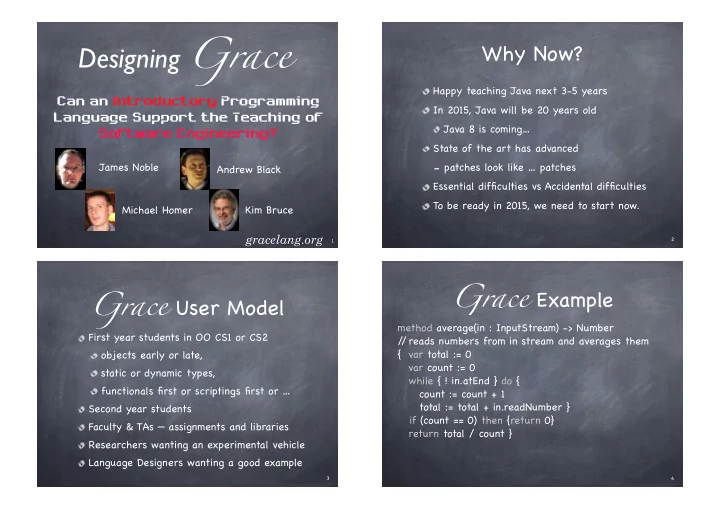

Designing Grace Why Now? Happy teaching Java next 3-5 years Can an Introductory Programming In 2015, Java will be 20 years old Language Support the Teaching of Java 8 is coming… Software Engineering? State of the art has advanced - patches look like … patches James Noble Andrew Black Essential difficulties vs Accidental difficulties To be ready in 2015, we need to start now. Michael Homer Kim Bruce gracelang.org 2 1 Grace Example Grace User Model method average(in : InputStream) -> Number First year students in OO CS1 or CS2 / / ! reads numbers from in stream and averages them { ! var total := 0 objects early or late, ! var count := 0 static or dynamic types, ! while { ! in.atEnd } do { functionals first or scriptings first or … ! count := count + 1 ! total := total + in.readNumber } Second year students if (count == 0) then {return 0} Faculty & TAs — assignments and libraries ! return total / count } Researchers wanting an experimental vehicle Language Designers wanting a good example 3 4
Object constructors Method Requests object { def x = 2 aPerson.printOn(outputStream) def y = 3 method distanceTo(other) { ((x - other.x)^2 + (y - other.y)^2) } printOn(outputStream) / / implicit self } ((x + y) > z) && !q ! ! / / operators are requests while { ! in.atEnd } do { print (in.readNumber) } ! ! ! ! ! ! ! ! ! ! / / multi-part method name 5 6 Object constructors Object constructors object { object { def x = 2 def x = 2 def y = 3 def y = 3 method distanceTo(other) { method distanceTo(other) { ((x - other.x)^2 + (y - other.y)^2) } ((x - other.x)^2 + (y - other.y)^2) } } } x 2 y 3 distanceTo(Point) ... 6 6
Classes class CartesianPoint.new(x’, y’) { def x = x’ def y = y’ Can an Introductory Programming method distanceTo(other) { ((x - other.x)^2 + (y - other.y)^2) } Language Support the Teaching of } Software Engineering? x 2 x 2 x 2 x 2 y 3 y 3 y 3 new(x,y) distanceTo(Point) y ... 3 distanceTo(Point) ... distanceTo(Point) ... distanceTo(Point) ... 7 8 Consistency Consistency Syntactic Consistency: Syntactic Consistency: if ( count == 0 ) { return 0 } / / C/Java if ( count == 0 ) { return 0 } / / C/Java if ( count == 0 ) then { return 0 } / / Grace if ( count == 0 ) then { return 0 } / / Grace Semantic Consistency: while ( x > 0 ) { other.iterate } / / C/Java while { x > 0 } do { other.iterate } / / Grace 9 10
Static vs. Dynamic Types Static vs. Dynamic Types class CartesianPoint.new(x’ , class CartesianPoint.new(x’ : Number , y ’ ) y ’ : Number ) -> Point { { def x = x‘ def x : Number = x‘ def y = y’ def y : Number = y’ method distanceTo ( other ) { method distanceTo(other : Point ) -> Number { ((x - other.x)^2 + (y - other.y)^2) } ((x - other.x)^2 + (y - other.y)^2) } } } 11 12 Implicit vs. Explicit Types vs Classes Declarations type Point = { JavaScript, FORTRAN: x -> Number y -> Number countr = counter + delta distanceTo(other : Point ) -> Number Pascal, C, Java, Ada… } def delta = 3 Types are separate from classes var counter := 0 Types need to be defined separately counter := counter + delta if (counter == 100) then { … } 13 14
Information Hiding Information Hiding def joe = object { def joe = object { var forename := "Joe" var forename is public, readable := "Joe" var surname := "Bloggs" var surname is public, readable := "Bloggs" var id := 234567 var id := 234567 method asString method asString is public {"Name: {forename} {surname} Id: {id}"} {"Name: {forename} {surname} Id: {id}"} } } print "joe is {joe}." / / error here print "joe is {joe}." / / works now 15 16 Formal Reasoning Formal Reasoning method gcd(m, n) { assert {(letters.size > 0) && (letters.size < 20)} assert {(m >= 0) & (n >= 0) & ((m != 0) | (n != 0))} var a := max(m,n) / / implementation of assert var b := min(m,n) method assert (block : Block<Boolean>) { while {b != 0} if ( ! block.apply ) invariant { a >= b } then {error "Assertion Failed"} do {def remainder = a % b } a := b b := remainder variant {b} return a } 17 18
Formal Reasoning Dialects dialect "loopinvariant" method for(collection) invariant( inv ) do( blk ) { import "mgcollections" as collections for (collection) do {element-> if (! inv.apply) then { def data = collections.list.new(2, 3, 4, 5) InvariantFailure.raise "Loop invariant not satisfied. ” } blk.apply(element) var sum : Number := 0 } for (data) invariant { sum >= 0 } do if (! inv.apply) then { { item : Number -> sum := sum + item } InvariantFailure.raise "Loop invariant not satisfied." } } 19 20 Can an Introductory Programming No conclusions — Language Support the Teaching of Software Engineering? we aren’ t done yet Grace : objects and method requests Questions Consistency: syntactic vs semantics Static vs Dynamic Types Comments Types vs Classes Suggestions Information Hiding Formal Reasoning Brickbats Dialects 21 22
Help! Teachers Supporters Students Programmers http:/ /gracelang.org Tech Writers Implementers Library Writers Textbook Authors IDE Developers!!!! Blog editors Testers Community Builders 23 24
Recommend
More recommend